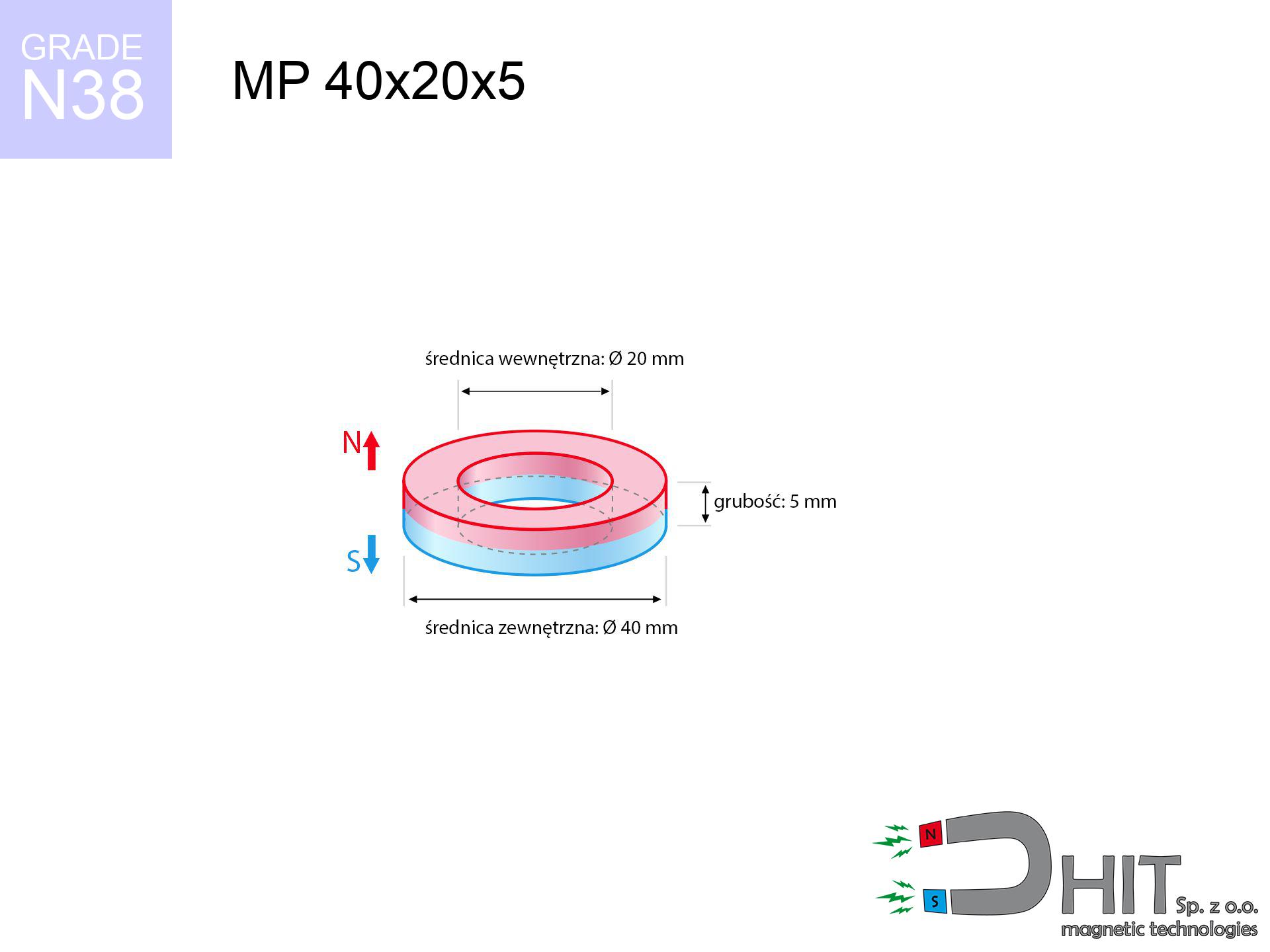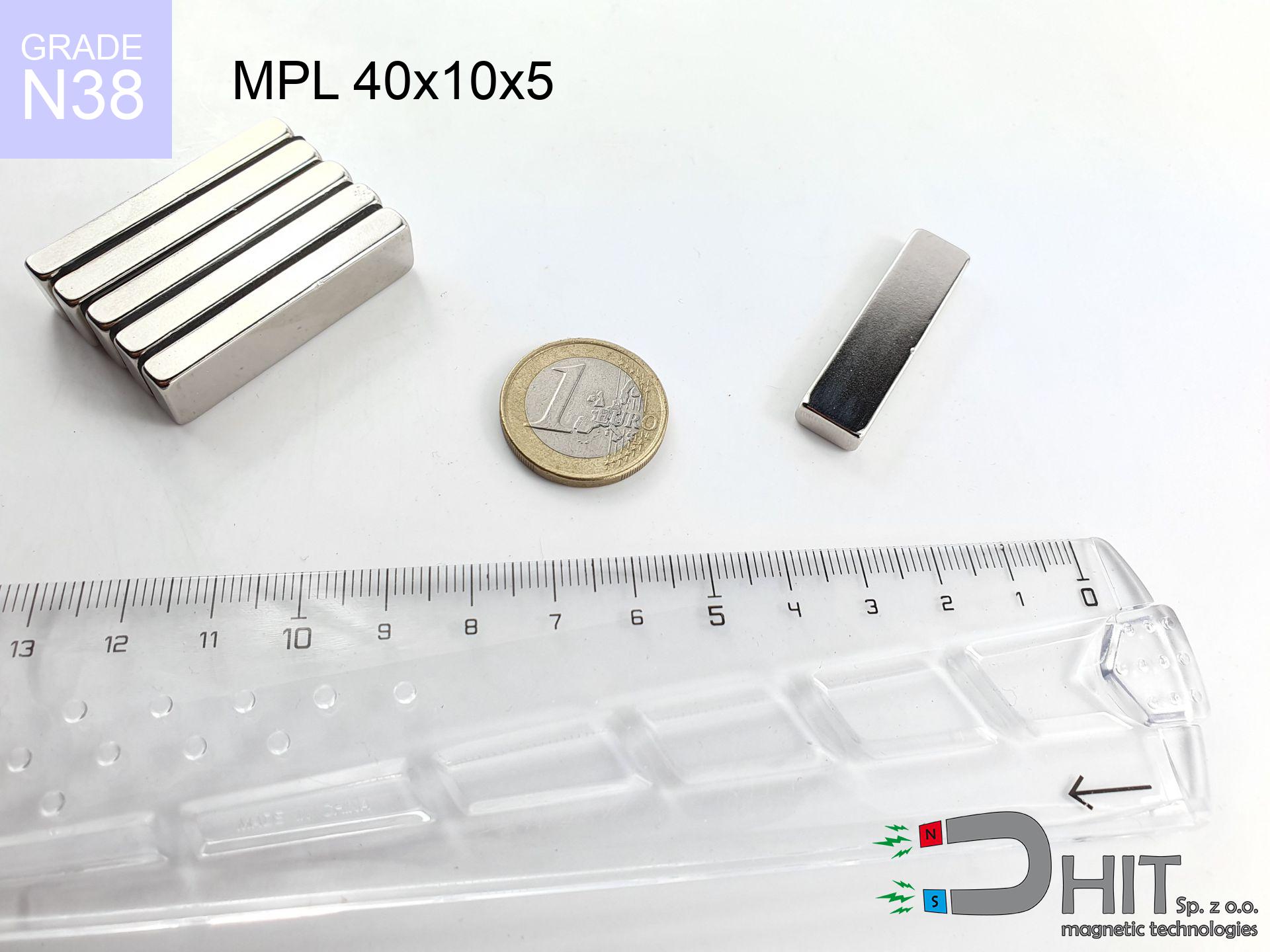MP 40x20x5 / N38 - ring magnet
ring magnet
Catalog no 030199
GTIN: 5906301812166
Diameter
40 mm [±0,1 mm]
internal diameter Ø
20 mm [±0,1 mm]
Height
5 mm [±0,1 mm]
Weight
23.56 g
Magnetization Direction
↑ axial
Load capacity
5.7 kg / 55.9 N
Magnetic Induction
126.81 mT
Coating
[NiCuNi] nickel
12.24 ZŁ with VAT / pcs + price for transport
9.95 ZŁ net + 23% VAT / pcs
bulk discounts:
Need more?Looking for a better price?
Call us
+48 22 499 98 98
or get in touch using
inquiry form
the contact form page.
Specifications as well as structure of neodymium magnets can be checked with our
our magnetic calculator.
Same-day shipping for orders placed before 14:00.
Magnetic properties of material N38
Physical properties of sintered neodymium magnets Nd2Fe14B at 20°C
Shopping tips
Pros and cons of neodymium magnets.
Besides their tremendous pulling force, neodymium magnets offer the following advantages:
- They virtually do not lose strength, because even after ten years the performance loss is only ~1% (in laboratory conditions),
- They show high resistance to demagnetization induced by external field influence,
- In other words, due to the metallic finish of nickel, the element gains a professional look,
- Neodymium magnets generate maximum magnetic induction on a contact point, which allows for strong attraction,
- Through (appropriate) combination of ingredients, they can achieve high thermal resistance, allowing for functioning at temperatures approaching 230°C and above...
- Possibility of exact forming as well as adjusting to specific applications,
- Huge importance in modern technologies – they are commonly used in HDD drives, electric motors, medical devices, and industrial machines.
- Thanks to efficiency per cm³, small magnets offer high operating force, occupying minimum space,
Disadvantages of NdFeB magnets:
- They are fragile upon heavy impacts. To avoid cracks, it is worth securing magnets in a protective case. Such protection not only shields the magnet but also improves its resistance to damage
- We warn that neodymium magnets can lose their power at high temperatures. To prevent this, we advise our specialized [AH] magnets, which work effectively even at 230°C.
- Due to the susceptibility of magnets to corrosion in a humid environment, we recommend using waterproof magnets made of rubber, plastic or other material resistant to moisture, when using outdoors
- Limited ability of making threads in the magnet and complex shapes - recommended is cover - magnet mounting.
- Health risk related to microscopic parts of magnets pose a threat, in case of ingestion, which gains importance in the aspect of protecting the youngest. Additionally, small components of these products are able to be problematic in diagnostics medical in case of swallowing.
- Higher cost of purchase is a significant factor to consider compared to ceramic magnets, especially in budget applications
Maximum magnetic pulling force – what affects it?
Breakaway force was defined for optimal configuration, assuming:
- on a block made of mild steel, optimally conducting the magnetic field
- whose thickness is min. 10 mm
- with an ground contact surface
- with zero gap (no paint)
- for force acting at a right angle (in the magnet axis)
- at temperature room level
Lifting capacity in real conditions – factors
In real-world applications, the actual lifting capacity results from many variables, ranked from crucial:
- Clearance – existence of foreign body (rust, dirt, air) acts as an insulator, which reduces capacity steeply (even by 50% at 0.5 mm).
- Load vector – maximum parameter is available only during perpendicular pulling. The shear force of the magnet along the surface is usually several times smaller (approx. 1/5 of the lifting capacity).
- Substrate thickness – for full efficiency, the steel must be adequately massive. Thin sheet restricts the lifting capacity (the magnet "punches through" it).
- Chemical composition of the base – mild steel gives the best results. Alloy admixtures decrease magnetic properties and lifting capacity.
- Surface finish – full contact is obtained only on polished steel. Any scratches and bumps create air cushions, reducing force.
- Thermal conditions – neodymium magnets have a negative temperature coefficient. At higher temperatures they lose power, and in frost they can be stronger (up to a certain limit).
* Lifting capacity was determined with the use of a polished steel plate of suitable thickness (min. 20 mm), under vertically applied force, whereas under shearing force the lifting capacity is smaller. In addition, even a small distance {between} the magnet and the plate reduces the lifting capacity.
H&S for magnets
Risk of cracking
Despite metallic appearance, the material is delicate and not impact-resistant. Avoid impacts, as the magnet may shatter into hazardous fragments.
Heat warning
Watch the temperature. Exposing the magnet above 80 degrees Celsius will destroy its properties and pulling force.
Magnetic media
Do not bring magnets close to a purse, laptop, or screen. The magnetism can permanently damage these devices and erase data from cards.
Physical harm
Danger of trauma: The attraction force is so great that it can result in blood blisters, pinching, and broken bones. Protective gloves are recommended.
Metal Allergy
Allergy Notice: The Ni-Cu-Ni coating contains nickel. If an allergic reaction appears, immediately stop handling magnets and use protective gear.
Fire warning
Mechanical processing of NdFeB material poses a fire hazard. Magnetic powder oxidizes rapidly with oxygen and is difficult to extinguish.
Warning for heart patients
Medical warning: Strong magnets can deactivate pacemakers and defibrillators. Stay away if you have medical devices.
Safe operation
Use magnets consciously. Their huge power can surprise even experienced users. Be vigilant and do not underestimate their power.
Keep away from children
Adult use only. Tiny parts pose a choking risk, leading to serious injuries. Store out of reach of kids and pets.
Keep away from electronics
Be aware: neodymium magnets generate a field that confuses precision electronics. Keep a separation from your mobile, device, and GPS.
Danger!
More info about hazards in the article: Safety of working with magnets.






![SM 32x200 [2xM8] / N52 - magnetic separator SM 32x200 [2xM8] / N52 - magnetic separator](https://cdn3.dhit.pl/graphics/products/sm-32x200-2xm8-tus.jpg)
![SM 25x300 [2xM8] / N42 - magnetic separator SM 25x300 [2xM8] / N42 - magnetic separator](https://cdn3.dhit.pl/graphics/products/sm-25x300-2xm8-kud.jpg)

